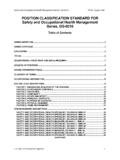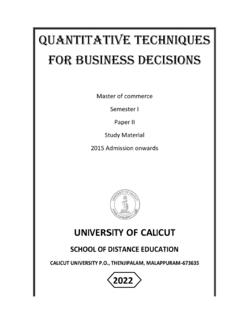Transcription of Function and Value of Advisory Boards for Academic ...
1 Function and Value of Advisory Boards for Academic Programs Types and Functions of Advisory Boards John McElroy, PhD, CFLE and Linda Dove, MS, ZA, Western Michigan University Creating and Maintaining a Family Studies Advisory Board Bryce Dickey, MS, CFLE, Western Michigan University The Role of Advisory Boards in Assessment Karen Blaisure, PhD, LMFT, CFLE, Western Michigan University Benefits of Advisory Boards for Students, Faculty and Board Members Linda Dove, MS, ZA, Western Michigan University Faculty and administrators at colleges and universities are accountable to stakeholders for the relevancy and quality of Academic programs.
2 Advisory Boards can support Academic program accountability by providing guidance and feedback and serving as partners in research and community collaborations. This symposium will address the roles of Advisory Boards in Academic programs. In four presentations, we will examine: 1) various types and functions of Boards ; 2) effective board construction and functioning; 3) examples of how a board participates in assessment; and 4) benefits of an Advisory board. We will weave lessons learned throughout the symposium and will allow for 30 minutes of discussion with audience members. Participants in the symposium will receive a packet of information that includes a summary of the points covered in the presentation, a graphic display of how an Advisory board fits within an assessment plan, and a resource list.
3 The first presentation will define the types and functions of Advisory Boards , with further description of those in use in departments of family studies and family and consumer education. The goal is for audience members to consider which type of board and what functions fit the needs of their respective Academic programs. The second presentation will use the twelve-year history of the Family Studies Advisory Board from Western Michigan University (WMU), from inception to the current effective board structure, to illustrate factors to consider when developing and maintaining a board.
4 Emphasis will be placed on lessons learned and acknowledging the contributions of board members. The third presentation will identify the role of a board in assessment of student learning outcomes. Four examples of how an Advisory board can assist in setting student learning outcomes, assess student learning in field experiences and internships, and guide curriculum enhancements will be reviewed. The last presentation will examine the benefits of Advisory Boards , including benefits to students, faculty, and board members. Types and Functions of Advisory Boards John McElroy, PhD, CFLE & Linda Dove, MS, ZA Higher education is increasingly using university-community board partnerships to support and strengthen fundamental missions (Seifer & Carrier, 2003).
5 This presentation will define, describe and provide a few existing examples of the types and functions of Advisory board collaborations. Definition An Advisory board is comprised of a group of university and community stakeholders from various local or regional institutions. In general, Boards tend to have multiple labels, flexible structures and different foci. However, a well-selected board will align around common interests in active participation, shared mission, and direct influence with students, faculty, and other board members (Taylor, Marino, Greenhalgh, & Hudak, 2010).
6 Board Varieties Since board types are differentiated by their institutional position in the organization s hierarchy (governing, Advisory , and line), their functioning (working or workgroup), and their economic charge (profit, non-profit and governmental), their structures and responsibilities vary (Carver, 2006). In this presentation, the functions of governing, Advisory and working Boards will be highlighted. Board Functions A governing board has authority to lead the organization from the top (Carver, 2006). They are responsible for articulating the organizational mission and executing institutional plans as well monitoring the effectiveness of programs, and serving as a fiduciary for the fiscal health of the organization (Kezar, 2006).
7 Hiring employees and CEO s, accounting oversight, establishing policies for personnel and staff evaluations fit under the governing board s responsibilities. In contrast, Advisory Boards are not expected to lead an organization. Their main Function is to offer support to institution administrators and faculty (Conroy, Lefever, & Withiam, 1996). Advisory Boards are comprised of accomplished experts offering innovative advice and dynamic perspectives (Stautberg & Green, 2007). Meeting quarterly or biannually, Boards can provide strategic direction, guide quality improvement, and assess program effectiveness (Taylor et.)
8 Al, 2010). Members diverse range of knowledge(s), skills and abilities inform Boards that are receptive to the culture of accepting outside ideas (Stautberg & Green, 2007). Working Boards can govern or advise. Their Function is to stay busy at multiple levels within an organization, making their institutional position the top, middle or bottom (Carver, 2006). Sometimes called workgroup Boards , these Boards Function as governing and/or advising Boards without the staff (Carver, 2006). This requires a high level of voluntary, uncompensated participation and underscores the work in working Boards .
9 Focus & University Models In higher education, Advisory collaborations have different emphases and foci. There are Advisory Boards that inform research, prevention and informed consent (Straus et. al, 2001). Others seek advice with curriculum content and job placement (Conroy et. al, 1996). Some more visible Advisory Boards , present in Family Studies are (Western Michigan University, Boise State and Kansas State), Family Therapy (Fairfield) and Family Consumer Sciences (Carson-Newman). University websites showcase Advisory member organizations, faculty profiles, mission statements and recent university initiatives that originate from Advisory board collaborations.
10 References Carver, J. (2006). Boards that make a difference. San Francisco, CA: John Wiley& Sons Conroy, P. A., Lafever, M. M., & Withiam, G. (1996). The Value of college Advisory Boards . Cornell Hotel and Restaurant Administration Quarterly, 37(4), 85-89. Kezar, A. (2006). Rethinking public board performance: Results of a national study of public governing Boards . The Journal of Higher Education. 77(6), 968-1008. Seifer, S., & Carriere, (2003, April). Symposium overview. National Symposium on Community-University Partnerships. San Diego: California. Retrieved from Stautberg, S.




